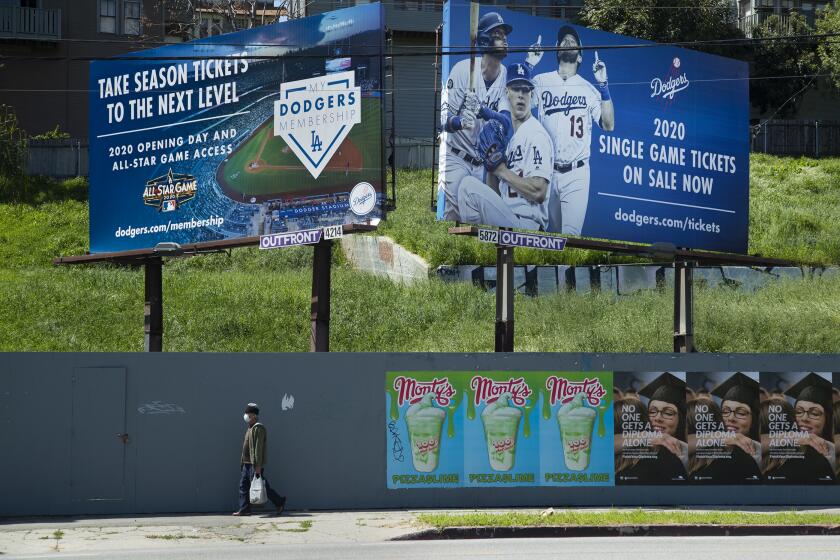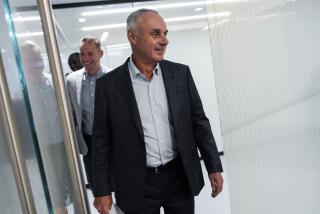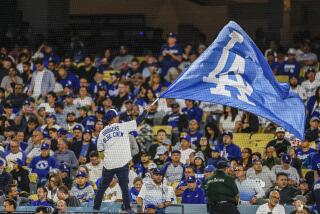MLB season startup: Here are the pros and cons of the three most likely scenarios
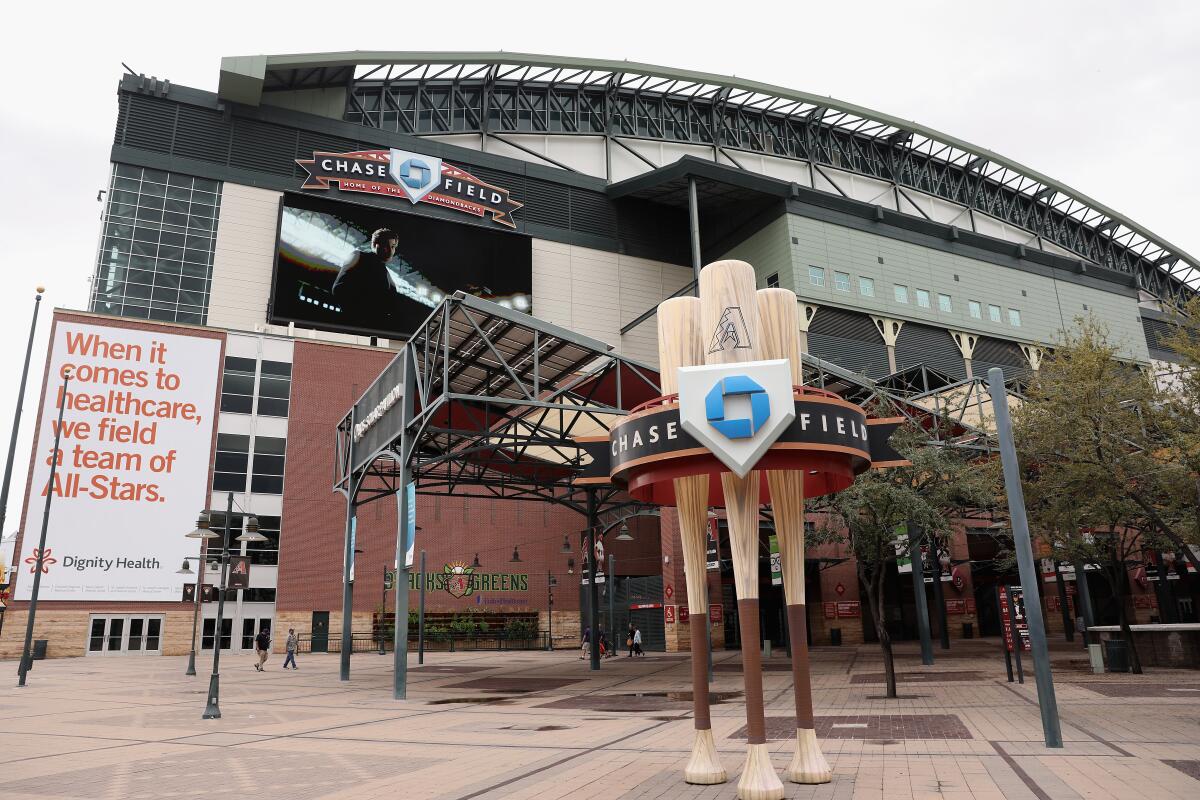
- Share via
Fourth in a series of articles about the 2020 futures of major sports leagues.
As government officials evaluate the medical and societal impacts of reopening parts of the country amid the COVID-19 pandemic, Major League Baseball must decide whether bringing its sport back and televising it to homebound fans is a worthwhile risk.
Support is mounting for MLB to spearhead the return to pseudo-normality. Some believe games could start by late June and that the abbreviated season could feature 100 games. Getting to that point would require some finesse.
It seems the only safe way to stage baseball this year would be with no fans in attendance. Any model likely would not include the minor leagues, would expand MLB rosters from their current 26 players and would require a taxi squad of reserves in case of injury. Virus testing would be necessary for anyone expected to enter a stadium. And players would require at least three weeks of spring training to prepare for the abbreviated season.
With that in mind, let’s look at three spectator-free proposals MLB is reportedly considering: a realignment that would allow teams to operate in their respective cities, an enclosed 30-team operation in Arizona, and a three-state hub.
Pro sports plan to play in empty venues because of the coronavirus outbreak, but examples of events occurring without fans is sparse.
Play and practice at home
Mike Trout and Clayton Kershaw objected to separating from their loved ones for prolonged stretches. So remaining in the Los Angeles area for another round of spring training and playing the regular season in familiar settings, while following local virus-combating procedures, would be palatable to them.
The basics of the plan, as reported by USA Today:
- Players would have access to most of the spoils of a regular season — MLB stadiums, familiar surroundings and charter flights, among other things — without sacrificing proximity to family.
- Teams would play only within three geographically friendly divisions during the regular season, which would limit travel to one region of the country. The format would change in the postseason.
- The number of people admitted into baseball’s work environments would be limited (likely to team officials and personnel, umpires and other game officials, broadcast crew and stadium staff), and all would be screened regularly for COVID-19 symptoms.
The wide-reaching system could be risky because players would return to their families after home games and their movements likely wouldn’t be closely monitored.
Behind-the-scenes dealings with government officials could also complicate matters. The 30 teams play in 28 cities. So not only would MLB have to contend with the policies of 17 states, Washington, D.C., and Toronto, it would also have to coordinate with the governments of 27 counties, the District of Columbia and the province of Ontario as well as respective city ordinances.
Exceptions would have to be made. In California, home to an MLB-leading five teams, sporting events without live audiences are not expected to be held until the third stage of Gov. Gavin Newsom’s four-phase plan for modifying stay-at-home orders is reached. That might not occur until August or September. But the governor indicated when he eased restrictions Monday that decision-making will be expanded to the local level.
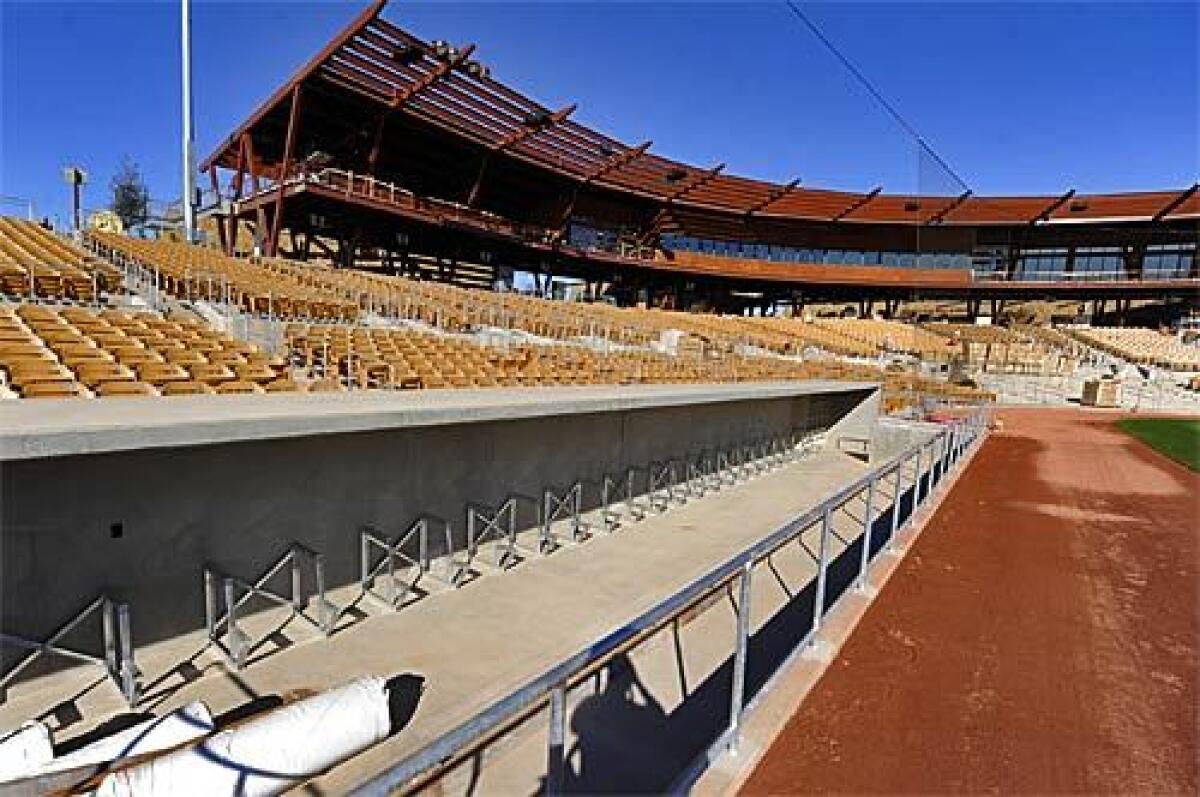
Support might not be hard to come by. President Trump, Govs. Greg Abbott (Texas), Andrew Cuomo (New York) and Tom Wolf (Pennsylvania), and Chicago Mayor Lori Lightfoot have encouraged baseball’s return this year. Senate Majority Leader Mitch McConnell (R-Ky.) told MLB Commissioner Rob Manfred last week, “America needs baseball.”
One feature of this plan would be especially sweet for Dodgers fans: The West division could pit the Dodgers against the Angels, San Francisco Giants, Oakland Athletics, San Diego Padres, Arizona Diamondbacks, Colorado Rockies, Texas Rangers, Seattle Mariners … and the Houston Astros, found guilty by MLB of cheating in their run-up to defeating the Dodgers in the 2017 World Series.
Send everyone to Arizona
The least risky plan would require all 30 teams to relocate to Arizona. It would also require the most restrictions and probably cause the most dissension among players.
Players, team personnel and others essential to baseball’s operation (such as umpires and broadcasters) would be isolated in hotels. They would travel only to Chase Field, the 10 spring training ballparks in the Phoenix area, and other local ballparks. There would be no room within what’s been termed as the “bubble” for anyone who refuses to follow the strict protocol. Departure from the bubble to attend to a family situation, such as the birth of a child, could require a two-week quarantine upon return.
The plan has raised concern that the frequent testing and protective equipment required for those within the bubble would jeopardize what is available to medical facilities and first responders as well as the general public.
Temperatures routinely over 100 degrees are also cause for concern, or at least discomfort.
Arizona Gov. Doug Ducey is receptive to the single-state proposal. So is Dr. Anthony Fauci, the nation’s top infectious disease expert.
MLB has considered whether to include the families of players. Doing so would greatly increase the demands for food, supplies and testing, but it might be the only way to persuade some players to participate.
The Dodgers offered refunds to people who bought tickets to home games in March and April that were canceled because of the coronavirus shutdown.
Host teams in Arizona, Texas and Florida
There are two covered MLB stadiums in both Texas and Florida and one in Arizona, as well as multiple spring training and minor league ballparks across all three states. That infrastructure would be utilized in MLB’s three-state plan, which would place teams in hubs.
It is unknown how MLB would place the teams in the states or how it would operate within that setting.
One possibility would be to cluster teams around the two covered stadiums in both Florida and Texas, where the weather is less predictable than in Arizona, and take advantage of the controlled settings there to host doubleheaders on a regular basis.
However, that strategy would likely require an unbalanced approach, such as placing six to eight teams in Texas, 12 to 14 in Florida, and the rest in Arizona.
Two of the country’s quickest-to-reopen states — Texas and Florida — are included in this three-state proposal. So are two states that have tested the fewest number of people: Texas and Arizona, according to the COVID Tracking Project.
Although data could improve by a possible restart date in July, MLB would have to consider safeguards if it decides to place multiple teams in areas where the spread of the novel coronavirus is not fully understood.
More to Read
Go beyond the scoreboard
Get the latest on L.A.'s teams in the daily Sports Report newsletter.
You may occasionally receive promotional content from the Los Angeles Times.

